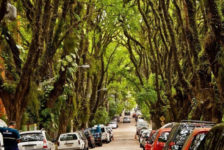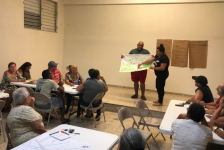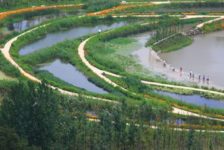For over 30 years in various capacities, I have taught the profession and craft of landscape architecture to university students. Sharing my love and passion for landscape architecture with students has been one of the great joys of my life. The academic, professional, and community recognition they have received for their individual and team work gives me great personal satisfaction. Yet with all this, I now wonder if I am adequately preparing my students for their future.
Our current students will face challenges unlike any faced by previous generations. Anthropogenic destruction of life and life-support systems has pushed the planet into an ecological emergency. Mass extinctions are accelerating. Human encroachment into the last wild places has given us the global pandemic.
And from the ecological emergency arise social emergencies. The botched US response to that pandemic coupled with an already wildly unequal economy may have created a depression that could last a decade. At the same time, the protectors and purveyors of systemic racism in the US seem hell bent on ensuring the country disintegrates into violence and hatred rather than see any challenge to White rule for the benefit of corporations.
Oh, almost forgot: 2020 will likely be the hottest year in recorded history, following the hottest decade in recorded history. Global heating has already triggered 9 of the 15 known tipping points of the planetary regulating system, potentially leading to a cascade of unstoppable, devastating climactic events. These could destabilize living conditions over large swaths of the planet, causing immense human suffering and likely leading to sustained global military conflict over the coming decades. Leading climate scientists recently published a paper in the journal Nature which concluded that “this is an existential threat to civilization.”
So yeah, today’s students got all that going for them, which is not nice.
How are we addressing this as landscape architecture educators? While much of landscape architectural education is timeless, I fear it is not evolving as urgently as the emergency demands. A great deal of today’s curriculum would be recognized by students of 50 years ago or longer and is suited for a planet and society that no longer exists.
There are so many ways in which our educational efforts need to progress – placing social and environmental justice at the absolute forefront of our work perhaps being chief among them. This means moving landscape architecture beyond what practitioner and educator Kate Orff sees as a narrow “realm of professional services.”
Concurring with that, Billy Fleming, the Director of Penn’s McHarg Center, has written that we must “reconstitute our discipline as something more than a client-driven enterprise” focused primarily only on sites. He directly challenges current landscape architectural education when he writes: “Can landscape architecture be both an instrument of neoliberalism and an activist force in the fights against climate change and for social justice? If it can’t, we need to find new ways of imagining our mission and disciplinary scope.” Among other things, this would involve creating “alternative models of practice in landscape architecture” involving training “a rising generation of landscape architects for careers in public service.”
Another vital way our educational efforts need to progress has to do with our relationship to energy. Our current educational system is premised on having essentially unlimited amounts of fossil fuels to enable our work. Climate science tells us that in order to do our best to avoid the most catastrophic impacts of global heating, we must end the use of fossil fuels within 20 years. Ending fossil fuels will absolutely transform society, and thus our profession. And if we don’t stop using them, then we likely will have locked in heating that may be undoable, leading to catastrophic conditions.
Either way, everything will change.
Regarding this, climate activist Rupert Read writes, “This civilization is coming to an end. Our societies need to transform ways of living so drastically that even if we prevent collapse the civilization that emerges will no longer be recognizable as this civilization.”
20 years is mid-career for students who are currently enrolled in landscape architecture programs. I worry that we are training them for a world that won’t exist then. This reality gives me a great deal of cognitive dissonance as an educator.
Thus we are – right now – between two worlds: an old one where we were confident of how the future would unfold and a new one where the only certainty is that radical transformations are on the way.
Therefore my dissonance: for which world are we teaching?
Ultimately, I am an optimist. I believe that we should educate students to be of use for the world where we come together globally to end fossil fuels, do everything possible to restore a livable climate, and stop the destruction of planetary life and life support systems. This is social and ecological justice, the very soul of Frederick Law Olmsted’s understanding of what this profession could be.
Doing this will be daunting. Alternatively, I guess we could educate students for a world where acceptance of, and attempted adaptation to, climate disaster and environmental destruction is the mainstream response. This seems to be the current default position. However, landscape architects should want no part of a world that simply accepts the greatest human rights violation ever perpetrated.
I believe – but maybe it’s just a hope – that landscape architecture is an instrument greatly needed to help us to reverse these crises. If it is to be, we have to get real about teaching to the new realities ASAP. The longer it takes us, the more planetary systemic disruptions will occur, which will make it that much harder for today’s students to succeed. I will do my part to help them.
—
Image: Licensed with CC BY-NC-ND 2.0.; 2018 year end Landscape Architecture Student Review on Friday, April 27, 2018 in the LA studios on the second floor of the E.S. Good Barn on the campus of the University of Kentucky.












Leslie B Wagle
…”the protectors and purveyors of systemic racism in the US seem hell bent on ensuring the country disintegrates into violence and hatred rather than see any challenge to White rule for the benefit of corporations.” Er….seems to me that there are also corporations pushing Critical Race Theory, and that violence and hatred is being fanned equally by Antifa and allies. Maybe you should name these protectors and purveyors? I hope this isn’t any part of your LA teaching framework.
J. Robert (Bob) Wainner
Sorry to inform you Steve…but, there is NO CHANCE that there will ever be an end to the use of Fossil Fuels…..are YOU going to force Nations like China, Russia, India, Iran and the rest of the World to stop uding Fossil Fuels….and go with all electric or renewables…..don’t think so.
And, maybe 2020 was possibloy the hottest day on record….I need to research that. But, here in The State of Texas in February 2021….we had a 100 YEAR COLD period!!! Weather changes…..always has and always will. The real “Ecological” Experts will tell you that MANKIND does not control the Weather on this Planet.
I’m getting pretty tired of reading all of these LAND 8 “WOKE” Liberal Blogs. It seems that ASLA and those LA’s who follow them….are just another wing of the Democratic/Socialist Party….along with Big Tech & the Liberal New Media.
WHY should the United States become 100% Fossil free….when 85% of the rest of the Nations refuse to? Their polluted AIR floats from their Nations to ours’ via the Jet Streams.